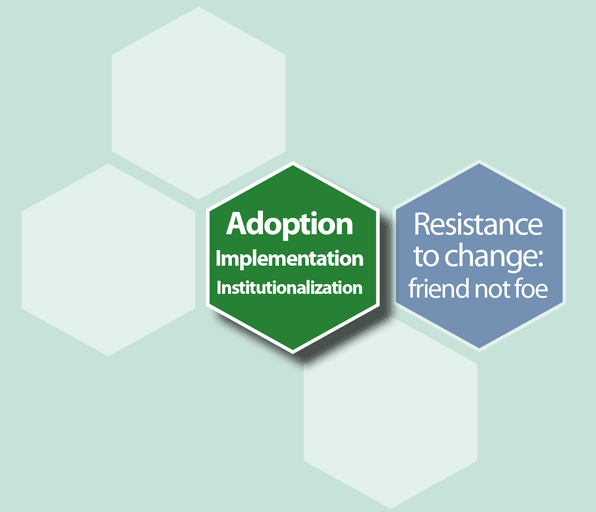Introduction
Implementing educational innovations in a medical curriculum can be one of the most satisfying parts of an educator’s job. However, and not infrequently, innovative ideas either do not get adopted, or even more frequently, are adopted without lasting. Understanding these three stages in a change process is an important first step in helping leaders and their supporters make a lasting difference in education. In this CORAL cell, you will be able to see when and how easily innovations become stalled or abandoned and how much work (time and energy) it takes to make even a great idea a lasting part of a program, course, or organization.
Learning Objectives (what you can reasonably expect to learn in the next 10-15 minutes):
- Distinguish among these three stages of change: adoption, implementation, and institutionalization
To what extent are you now able to meet this objective above? Please record your self-assessment. (0 is Not at all and 5 is Completely)
As a warm up, record what you think each of these terms means. Rely on the meaning of the English words or on any prior exposure you may have had to these terms from other courses or interactions around change in education and/or health care.
Adoption
Implementation
Institutionalization
Now proceed to the rest of this CORAL Cell.
Adoption, Implementation, Institutionalization

Adoption, implementation, and institutionalization are useful concepts for organizing our thoughts around educational change. This framework with the three stages has limitations but is nevertheless useful in understanding some aspects of the change process (as are the other frameworks).
Adoption is that process whereby changes are accepted or approved by an individual or organizational unit. Adoption by an individual might look like an ambulatory clinic director approving and starting to use the “One Minute Preceptor” model in the clinic. Adoption by an organization would include a curriculum committee or department education committee passing a motion in favour of simulation training or a new topic area for a course or series of lectures. The emphasis at this stage is the formal approval of a change. Getting a proposed change to the agenda is not yet adoption but a necessary pre-requisite step.
Many times committees or administrators might approve a particular direction or initiative but it just does not make it from the minutes of the meeting to the classroom or clinic. It never gets implemented or used. It is beyond the scope of this cell to describe all the reasons why this might be the case but there are many: lack of resource, lack of leadership, and even human error. Implementation is that stage of the change process where the initiative is actually used, even just one time.
Once implemented, the initiative or program or new materials might not be used in the manner intended by those who designed or approved them. Often it is not those who adopt the innovation that end up using it. There is quite some concern among program evaluators about the “fidelity” of the implementation. Fidelity refers the standardization or replicability of a program being implemented. Generally, evaluators have found that the greater the fidelity the better the outcomes and the lesser the fidelity the worse the outcomes. However, some redefining, restructuring, adaptation and modification by the users at the local level can be helpful especially where national or large scale changes are being implemented (such as Competency by Design).
Institutionalization in this model is the final stage of the change process (until we start again with a better innovation). At this stage the organization fully supports and “owns” what was once a “new” initiative. It becomes just another program that happens as a part of routine business and it is supported with policy and resources. It can even survive the retirement of the person who first started and organized the innovation. The long term continuation of the change is no longer at risk and the embedding process is secure.
These three terms taken together help describe the change process whether in health, education, or government. This simple metaphor sums up much of what we have said about them: Adoption is deciding to push a specific boulder up a particular hill. Implementation is starting to push that boulder up the right hill at the right time in the right way (fidelity). Institutionalization is getting the whole town to push the boulder to the top of the hill where it can stay year after year after year!
Check for Understanding
Self-assessment
To what extent are you NOW able to meet the following objectives? (0 is not at all and 5 is completely)
To what extent WERE you able the day before beginning this CORAL Cell to meet the following objectives? (0 is not at all and 5 is completely)

Thank you for completing this CORAL Cell. We are interested in improving this and other cells and would like to use your answers (anonymously of course) along with the following descriptive questions as part of our evaluation data.
Thanks again, and come back soon!
The CORAL Cell Team
References
Graham CR, Woodfield W, Harrison JB. A framework for institutional adoption and implementation of blended learning in higher education. The internet and higher education. 2013 Jul 31;18:4-14.
Pierce JL, Delbecq AL. Organization structure, individual attitudes and innovation. Academy of management review. 1977 Jan 1;2(1):27-37.
Dusenbury L, Brannigan R, Falco M, Hansen WB. A review of research on fidelity of implementation: implications for drug abuse prevention in school settings. Health education research. 2003 Apr 1;18(2):237-56.
Further reading:
*Rogers E. Diffusion of Innovations. Collier-Macmillan Canada Ltd: 1962.
*Cited by almost 90,000!
Credits:
Authors: Marcel D’Eon, University of Saskatchewan; Irene Ma, University of Calgary
Series Editor: Marcel D’Eon
Reviewer/consultant: Irene Ma, University of Calgary
